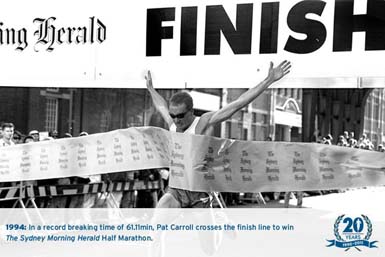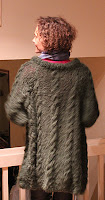A record volume of training begins easy, or so it seems. In fact it never appears to get that difficult when you look at each daily session in isolation. Sure, there are the challenging workouts that call for half marathon-, or marathon-, race pace for a few kilometres; but these are done only once a week.
Yet I know that my biggest challenge will be to sustain the regimen for the next four months. Yesterday I started what is meant to be a daily running spree of 130 consecutive days. One week away from embarking on an 18-week program that kicks off with a week of 104km of running, I have planned a relatively easy 90km in the final week of 2011, right between Christmas and New Year's.
Easy, as in that this week has no speed sessions. It began with a 12km run at recovery pace/effort yesterday. I chose a route that for a large part follows a forest service road along the Stawamus River, and then veers onto a trail that runs parallel to Highway 99 and takes you to the bottom of the Chief. It's a lovely, mildly undulating run.
It's also the road where a body was found earlier this year. While it was hard not to ponder this, I reminded myself that one body does not make this a creepy route; I focused on the more important fact that I was running along a road that offers access to trails taking you to some of the fabulous hiking and climbing that Squamish has to offer.
It's a little bit like our former neighbours telling Tim and I about our home's previous owner's wife dying suddenly and unexpectedly of a heart condition in our house, before adding, "Geez, you look
so much like her!" when they invited us over for the first time on New Year's Eve three years ago. I opted to consider the context of that remark one that had nothing to do with us, or our home.
There is always more than one way to look at things including a focus on athletic performance; some people remark that my focus is 'inspiring', while I also get suggestions to go 'enjoy some skiing ... not just running'. Whether a runner is focused or obsessed all depends on your point of view.
Or, does it?
I rarely wonder if my passion for running, and improving performance, is an unhealthy one; it simply does not feel that way. But it's good to check every now and then, especially when gearing up for a schedule of which the creator, Pete Pfitzinger, writes (emphasis is mine):
"These schedules are challenging right from the start and get harder as your marathon approaches. So that you can progress as the training increases in quantity and quality and to minimize your chances of injury, you should be able to complete the first week of the schedule without too much effort."
"The schedules are presented in a day-by-day format...
The main limitation with this approach is that it's impossible to guess the myriad of outside factors that may influence your day-to-day nonrunning life (assuming you still have one at this level of volume)."
I, and many runners no doubt, often hear: "Oh, I don't have time for that."
How would time be different for (non-professional) runners? We are all given 24 hours in a day. Anyone who reads this blog will either own a computer or have access to one; in other words, we are rich, fortunate, privileged people. That means we have a choice as to how we spend our free time; I choose to spend much of mine training for marathons.
The flipside of that comment is an implication that a serious amateur runner is obsessed with, even addicted, to a pursuit most would consider irrelevant: What's the point of spending so much time and energy on running a few minutes faster, unless you're an elite athlete with a shot at a major title?
Yesterday, as I had a brief rest on the couch after finishing those first 12 of the 2,170 kilometres I hope to cover in 19 weeks (an average of 16.7km a day), I read a section of
Lore of Running in
Chapter 8: Training the Mind that talks about "the psychological addiction of running".
(Incidentally, it follows the section on "psychological benefits of running" which include a positive state of mind, reduced tension and anxiety, decreased depression, increased quality of life, positive personality traits, and improved mental functioning).
Starting on p.548 of the fourth edition and finishing on p.556, Tim Noakes works through the literature citing arguments for and against running being detrimental as it is addictive, adding his own extensive experience and research to the mix, before writing:
"My conclusion then is that marathon runners come from that segment of the human population whose brains have evolved to reward prolonged, sustained activity of moderate to low intensity. Perhaps we are the direct descendants of that group of humans - the ancestral hunters - who outran their prey during many hours of pursuit.
"Our reward was not the slain animals but the gorgeous feelings of tranquility and universal insight that the prolonged chase produced. Far from feeling tired, I suspect that this physiological response spurred the ancestral hunters with the desire to hunt each day, clearly an important survival strategy."
A hunter wired to run, rather than an addict. Or a fighter.
"Others... " writes Noakes, "were designed to protect the tribe from predation by wild animals and other marauding humans... Since fighting, and not hunting, was probably the more important activity of ancestral humans, so it may be that the fighting, and not the running, brain is in the majority of modern human populations."
"[w]ithout the essential physiological basis, I believe that we would not be runners, irrespective of the seemingly plausible psychological explanations for our compulsion. I believe we run because the brain demands it and rewards us with desirable feelings and emotions when we follow its commands."
Michael Sachs (among the authors cited by Noakes) wrote this 1998
Marathon & Beyond article
"Too much of a good thing?"
It also offers an "addiction self-test" created by the magazine's editor, Rich Benyo, also an author and runner.
Click here to take the test - scroll to the bottom of the article.
After ranking the first statement
(Running is extremely important to me. I'm positive I'll be running for the rest of my life.) with a 10, I only agreed as strongly with one other,
(Warm-up and cool-down are important, but it's what comes in the middle of the workout that counts).
My overall score for the test was 52, which put me in the lower part of the "Fitness with a mellow bent"-category, only 12 points above "Approaching terminal mellow; better sign up for a race"-group. That's good to know.




















